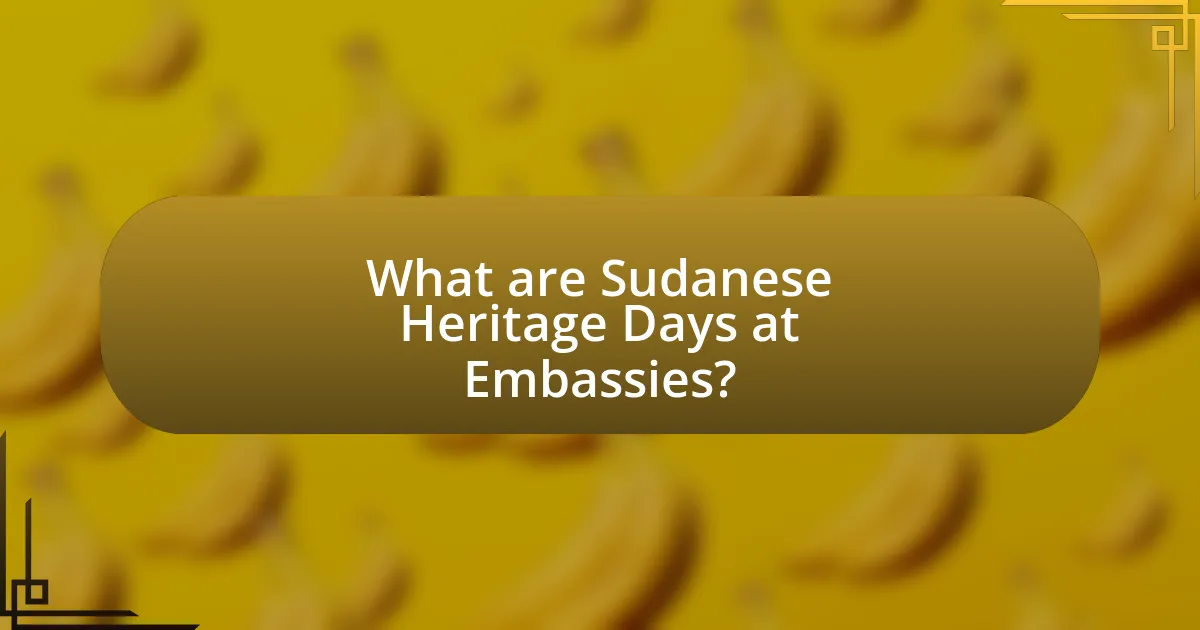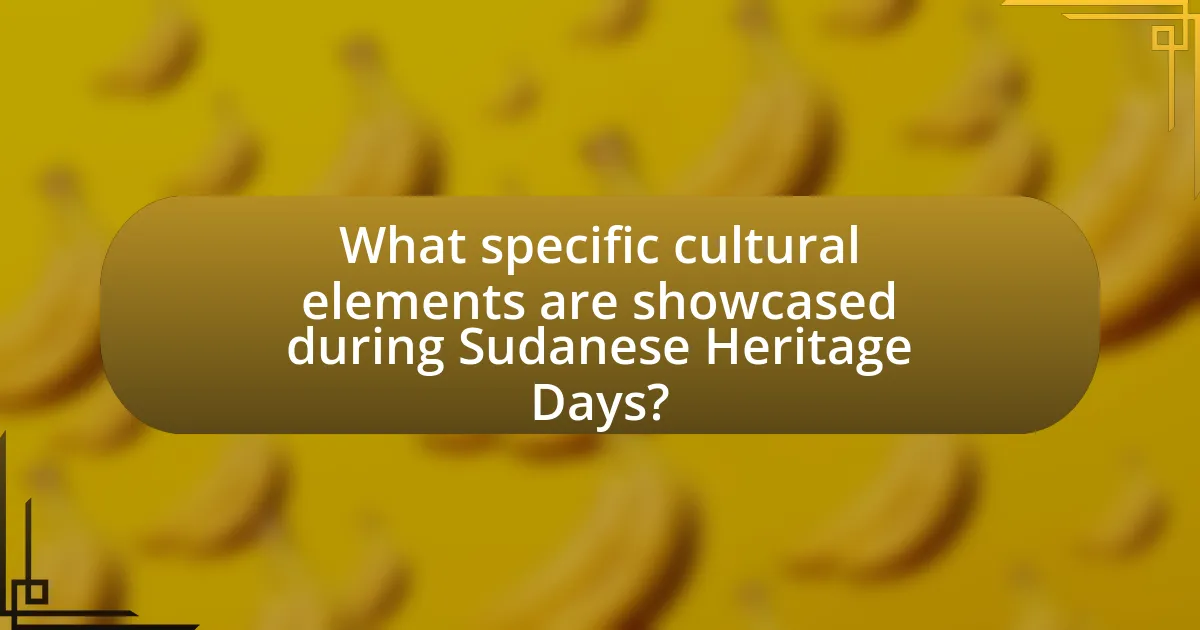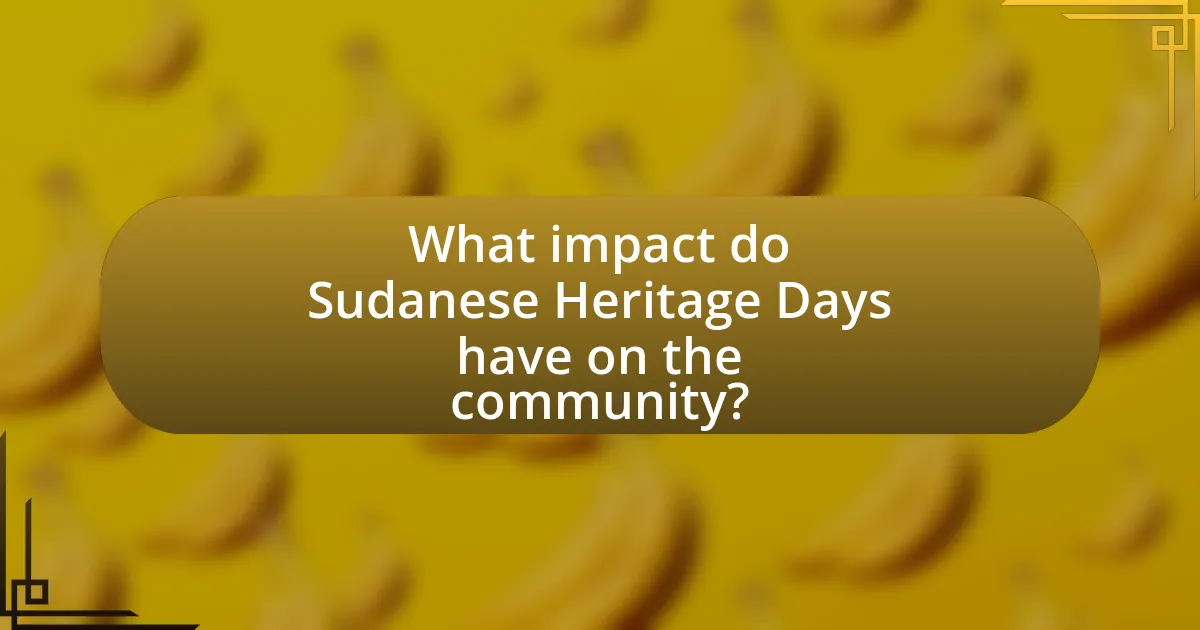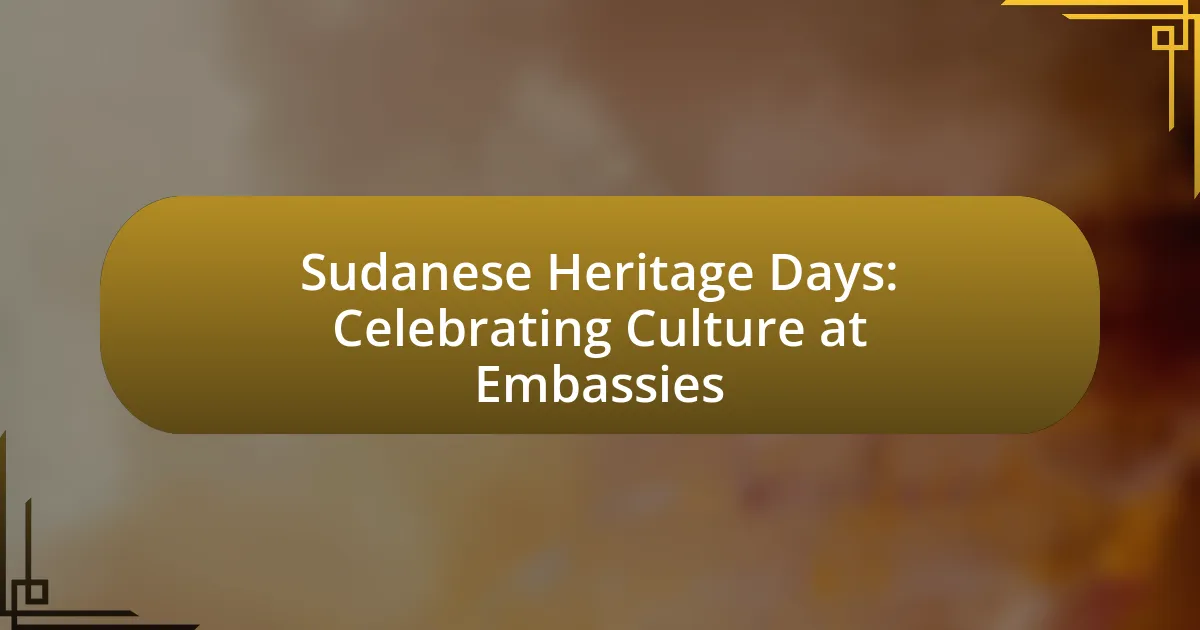Sudanese Heritage Days at Embassies are cultural events organized by Sudanese diplomatic missions to celebrate and promote Sudanese culture, traditions, and heritage. These events feature cultural exhibitions, traditional music and dance performances, culinary showcases, and discussions on Sudanese history and art, aimed at fostering cultural exchange and awareness. The article explores how these events promote cultural awareness, the activities included, the role of embassies in cultural diplomacy, and the historical significance of Sudanese Heritage Days. Additionally, it addresses the impact on community engagement, challenges faced by organizers, and best practices for successful events.

What are Sudanese Heritage Days at Embassies?
Sudanese Heritage Days at Embassies are events organized by Sudanese diplomatic missions to celebrate and promote Sudanese culture, traditions, and heritage. These events typically feature cultural exhibitions, traditional music and dance performances, culinary showcases, and discussions on Sudanese history and art, aimed at fostering cultural exchange and awareness among diverse audiences. Such initiatives help strengthen the connection between Sudan and the international community, highlighting the richness of Sudanese culture and its contributions to global heritage.
How do Sudanese Heritage Days promote cultural awareness?
Sudanese Heritage Days promote cultural awareness by showcasing Sudanese traditions, arts, and history to diverse audiences. These events facilitate cultural exchange through activities such as traditional music performances, art exhibitions, and culinary experiences, allowing attendees to engage with and appreciate Sudanese culture. For instance, the inclusion of Sudanese folklore and storytelling during these events highlights the rich cultural narratives that define Sudanese identity, fostering understanding and respect among different communities.
What activities are typically included in Sudanese Heritage Days?
Sudanese Heritage Days typically include cultural exhibitions, traditional music and dance performances, culinary showcases featuring Sudanese cuisine, and workshops on traditional crafts. These activities aim to celebrate and promote Sudanese culture and heritage, allowing attendees to engage with the rich traditions of Sudan. For instance, cultural exhibitions often display artifacts and artworks that reflect Sudan’s history, while culinary showcases provide an opportunity to taste dishes like ful medames and kisra, which are integral to Sudanese identity.
How do these activities reflect Sudanese culture?
Sudanese Heritage Days activities reflect Sudanese culture by showcasing traditional music, dance, cuisine, and art that are integral to the nation’s identity. These events often feature performances of folk dances like the “Hawiya” and “Dabke,” which highlight communal values and storytelling traditions. Additionally, the presentation of Sudanese dishes, such as “Ful Medames” and “Kisra,” emphasizes the importance of hospitality and culinary heritage in Sudanese society. Art exhibitions displaying local crafts and textiles further illustrate the rich artistic expressions rooted in Sudan’s diverse ethnic backgrounds. Collectively, these activities serve to preserve and promote Sudanese cultural heritage, fostering a sense of community and pride among participants and attendees.
Why are embassies important for celebrating Sudanese heritage?
Embassies are important for celebrating Sudanese heritage because they serve as cultural hubs that promote and preserve Sudanese traditions, art, and history. By organizing events such as Sudanese Heritage Days, embassies facilitate cultural exchange and awareness among diverse audiences, showcasing Sudan’s rich cultural tapestry. For instance, embassies often host exhibitions, performances, and culinary events that highlight Sudanese customs, fostering a deeper understanding and appreciation of Sudanese identity in the international community.
What role do embassies play in cultural diplomacy?
Embassies play a crucial role in cultural diplomacy by serving as platforms for promoting and exchanging cultural values between nations. They organize events, such as art exhibitions, music performances, and cultural festivals, which showcase the heritage and traditions of their home countries. For instance, during Sudanese Heritage Days, embassies facilitate cultural exchanges that enhance mutual understanding and foster relationships between Sudan and the host country. This engagement not only highlights Sudanese culture but also encourages dialogue and collaboration, reinforcing the importance of cultural diplomacy in international relations.
How do embassies engage with local communities during these events?
Embassies engage with local communities during Sudanese Heritage Days by organizing cultural events that showcase Sudanese traditions, art, and cuisine. These events often include exhibitions, performances, and workshops that invite local participation, fostering cultural exchange and understanding. For instance, embassies may collaborate with local artists and cultural organizations to create programs that highlight Sudanese music and dance, thereby enhancing community involvement and appreciation for Sudanese heritage.
What is the historical significance of Sudanese Heritage Days?
Sudanese Heritage Days hold historical significance as a celebration of Sudan’s rich cultural diversity and heritage, fostering national identity and unity among Sudanese communities. Established to promote awareness of Sudanese traditions, arts, and history, these events serve as a platform for cultural exchange and dialogue, particularly in diaspora communities. The observance of Sudanese Heritage Days reflects the country’s historical narratives, including its ancient civilizations, such as the Kingdom of Kush, and the impact of colonialism, which shaped modern Sudanese identity. By highlighting traditional music, dance, cuisine, and crafts, these days reinforce the importance of preserving cultural practices and passing them on to future generations.
How have these celebrations evolved over time?
Sudanese Heritage Days have evolved from informal gatherings to structured cultural events at embassies, reflecting a growing recognition of Sudanese culture globally. Initially, these celebrations focused on local customs and traditions, but over time, they have incorporated a wider array of cultural expressions, including music, dance, and cuisine, showcasing the diversity within Sudanese heritage. This evolution is evidenced by increased participation from the Sudanese diaspora and collaboration with local communities, enhancing cultural exchange and awareness.
What milestones have marked the history of Sudanese Heritage Days?
Sudanese Heritage Days have been marked by several significant milestones, including the inaugural celebration in 2005, which aimed to promote Sudanese culture and heritage globally. This event has since expanded to include various activities such as art exhibitions, traditional music performances, and culinary showcases, fostering cultural exchange and awareness. In 2010, the event gained official recognition from the Sudanese government, further solidifying its importance in promoting national identity abroad. Additionally, the participation of Sudanese embassies worldwide has increased, with events held in countries like the United States, Canada, and several European nations, highlighting the global reach and impact of Sudanese Heritage Days.

What specific cultural elements are showcased during Sudanese Heritage Days?
Sudanese Heritage Days showcase specific cultural elements such as traditional music, dance, cuisine, and art. These events highlight Sudan’s rich cultural diversity, featuring performances of folk dances like the “Hawiya” and “Dabke,” which are integral to Sudanese celebrations. Additionally, attendees experience authentic Sudanese dishes, including “Ful Medames” and “Kisra,” which reflect the country’s culinary heritage. Art exhibitions display traditional crafts, textiles, and calligraphy, emphasizing Sudan’s artistic expressions. These elements collectively celebrate Sudan’s cultural identity and heritage during the events.
How is Sudanese cuisine represented at these events?
Sudanese cuisine is prominently represented at these events through the showcasing of traditional dishes, which highlight the country’s rich culinary heritage. Events often feature popular Sudanese foods such as ful medames (fava beans), kisra (sourdough flatbread), and various stews, allowing attendees to experience authentic flavors. Additionally, cultural demonstrations and cooking sessions provide insights into the preparation methods and ingredients unique to Sudanese cooking, reinforcing the significance of food in Sudanese culture.
What traditional dishes are commonly featured?
Traditional dishes commonly featured during Sudanese Heritage Days include Ful Medames, a fava bean dish often served with bread, and Kisra, a fermented flatbread made from sorghum. Additionally, dishes like Tagine, a slow-cooked stew, and Molokhia, a leafy green soup, are also prevalent. These dishes reflect Sudan’s rich culinary heritage, which is influenced by various cultures and ingredients native to the region.
How does food play a role in cultural identity during the celebrations?
Food serves as a vital expression of cultural identity during celebrations, particularly in the context of Sudanese Heritage Days at embassies. Traditional dishes, such as kisra and tagine, not only reflect Sudanese culinary practices but also symbolize the shared history and values of the community. These foods are often prepared using recipes passed down through generations, reinforcing familial and cultural bonds. Additionally, the act of sharing meals during celebrations fosters a sense of belonging and unity among participants, allowing individuals to connect with their heritage and each other. This connection is further emphasized by the communal nature of dining, where food becomes a medium for storytelling and cultural exchange, highlighting the importance of culinary traditions in maintaining and celebrating cultural identity.
What forms of art and music are highlighted during Sudanese Heritage Days?
Sudanese Heritage Days highlight traditional music and visual arts, including folk music, dance performances, and crafts such as weaving and pottery. These forms of art and music reflect Sudan’s diverse cultural heritage, showcasing regional styles and instruments like the oud and tambour. The events often feature performances that celebrate Sudanese history and community, reinforcing cultural identity and pride.
Which traditional art forms are showcased?
The traditional art forms showcased during Sudanese Heritage Days include traditional music, dance, handicrafts, and visual arts. These art forms reflect Sudan’s rich cultural heritage, with traditional music often featuring instruments like the oud and tambourine, while dances such as the ‘Hawiya’ and ‘Dabke’ highlight community and celebration. Handicrafts, including weaving and pottery, demonstrate the skills passed down through generations, and visual arts often depict historical and cultural themes significant to Sudanese identity.
How does music contribute to the overall experience of the event?
Music enhances the overall experience of the event by creating an immersive atmosphere that reflects Sudanese culture. It serves as a medium for cultural expression, allowing attendees to connect emotionally with the heritage being celebrated. For instance, traditional Sudanese music, characterized by unique rhythms and instruments, fosters a sense of community and belonging among participants. Research indicates that music can evoke strong emotional responses, which can enhance engagement and enjoyment during cultural events. This emotional connection is crucial for deepening the appreciation of Sudanese traditions and fostering a shared cultural identity among attendees.
How do storytelling and folklore contribute to the celebrations?
Storytelling and folklore significantly enhance celebrations by preserving cultural identity and fostering community bonds. In the context of Sudanese Heritage Days, these narratives serve as a medium to transmit historical events, moral lessons, and traditional values, thereby enriching the celebratory atmosphere. For instance, the oral traditions of Sudan, such as tales of historical figures and significant events, are shared during these festivities, allowing participants to connect with their heritage. This practice not only entertains but also educates attendees about their cultural roots, reinforcing a sense of belonging and continuity within the community.
What types of stories are shared during Sudanese Heritage Days?
During Sudanese Heritage Days, stories shared typically include narratives about traditional customs, historical events, and personal experiences that reflect Sudanese culture and identity. These stories often highlight the rich tapestry of Sudan’s diverse ethnic groups, showcasing folklore, music, dance, and culinary traditions. For instance, participants may recount tales of ancient kingdoms, significant cultural practices, or family histories that emphasize the importance of community and heritage in Sudanese society.
How do these stories reflect Sudanese values and traditions?
Sudanese stories reflect values and traditions by emphasizing community, resilience, and respect for heritage. These narratives often showcase the importance of family ties and social cohesion, illustrating how collective experiences shape individual identities. For instance, tales of historical figures or events highlight the significance of bravery and perseverance in the face of adversity, which are core Sudanese values. Additionally, storytelling serves as a medium for passing down cultural practices and moral lessons, reinforcing the connection to Sudanese customs and beliefs. This cultural transmission is vital for maintaining a sense of identity among Sudanese people, especially in diaspora communities.

What impact do Sudanese Heritage Days have on the community?
Sudanese Heritage Days significantly enhance community cohesion and cultural awareness. These events foster a sense of belonging among Sudanese individuals by celebrating their unique traditions, music, and cuisine, which strengthens community ties. Additionally, they promote cultural exchange by inviting diverse audiences to engage with Sudanese heritage, thereby increasing understanding and appreciation of Sudanese culture within the broader society. This impact is evidenced by increased participation in community events and positive feedback from attendees regarding their experiences and newfound knowledge about Sudanese traditions.
How do these events foster community engagement?
Sudanese Heritage Days foster community engagement by providing a platform for cultural exchange and interaction among diverse groups. These events encourage participation from both Sudanese nationals and local communities, facilitating dialogue and understanding through shared cultural experiences such as traditional music, dance, and cuisine. Research indicates that cultural events enhance social cohesion, as evidenced by a study from the National Endowment for the Arts, which found that participation in cultural activities increases community ties and civic involvement.
What opportunities do they create for cultural exchange?
Sudanese Heritage Days at embassies create opportunities for cultural exchange by showcasing Sudanese traditions, art, and cuisine to diverse audiences. These events facilitate interactions between Sudanese communities and local populations, fostering mutual understanding and appreciation of cultural diversity. For instance, through traditional music performances and culinary demonstrations, attendees gain firsthand experience of Sudanese culture, which enhances cross-cultural dialogue and strengthens international relationships.
How do they strengthen ties among Sudanese expatriates?
Sudanese Heritage Days strengthen ties among Sudanese expatriates by fostering community engagement and cultural exchange. These events provide a platform for expatriates to connect through shared traditions, food, music, and art, reinforcing their cultural identity. For instance, during these celebrations, attendees participate in traditional dances and culinary showcases, which enhance social bonds and create a sense of belonging. Additionally, the involvement of Sudanese embassies in organizing these events facilitates networking opportunities, allowing expatriates to build relationships and support systems within their diaspora.
What challenges do organizers face in hosting Sudanese Heritage Days?
Organizers face several challenges in hosting Sudanese Heritage Days, including logistical issues, cultural representation, and funding constraints. Logistical issues arise from coordinating events, securing venues, and managing schedules, which can be complicated by varying regulations in different countries. Cultural representation is critical, as organizers must ensure that the diverse aspects of Sudanese culture are accurately and respectfully showcased, which requires collaboration with various community groups. Funding constraints often limit the scale and scope of events, making it difficult to provide adequate resources for activities, marketing, and outreach. These challenges can hinder the successful execution of Sudanese Heritage Days and impact community engagement.
How do logistical issues affect the planning of these events?
Logistical issues significantly impact the planning of Sudanese Heritage Days at embassies by complicating coordination and resource allocation. These challenges include transportation of cultural materials, scheduling conflicts with embassy staff, and securing necessary permits for events. For instance, delays in shipping traditional artifacts can hinder the exhibition timeline, while miscommunication regarding event dates can lead to low attendance. Additionally, logistical constraints can affect budget management, as unexpected costs may arise from last-minute changes or inadequate planning.
What strategies are used to overcome cultural misunderstandings?
To overcome cultural misunderstandings, strategies such as active listening, cultural sensitivity training, and open communication are employed. Active listening involves fully concentrating on the speaker, which helps in understanding diverse perspectives and reducing misinterpretations. Cultural sensitivity training educates individuals about different cultural norms and values, fostering respect and awareness. Open communication encourages dialogue, allowing individuals to express their thoughts and clarify any misconceptions. These strategies are supported by research indicating that effective communication and cultural awareness significantly reduce conflicts and enhance collaboration in multicultural settings.
What best practices can be adopted for successful Sudanese Heritage Days?
To ensure successful Sudanese Heritage Days, it is essential to engage the community through inclusive programming that highlights Sudanese culture, history, and traditions. This can be achieved by organizing workshops, cultural performances, and exhibitions that showcase traditional crafts, music, and cuisine, thereby fostering a deeper understanding and appreciation of Sudanese heritage among attendees.
Additionally, collaboration with local Sudanese organizations and artists can enhance authenticity and participation, as evidenced by successful events in various embassies that have utilized local talent to create a vibrant atmosphere. Promoting the event through social media and community outreach ensures a wider audience, increasing attendance and engagement.
Furthermore, incorporating educational components, such as lectures or discussions on Sudanese history and contemporary issues, can provide valuable context and enrich the experience for participants. These practices collectively contribute to a meaningful celebration of Sudanese culture, ensuring that Heritage Days are both impactful and memorable.
How can organizers effectively promote these events?
Organizers can effectively promote Sudanese Heritage Days by leveraging social media platforms, engaging local communities, and collaborating with cultural institutions. Utilizing social media allows for targeted outreach, as platforms like Facebook and Instagram can reach diverse audiences interested in cultural events. Engaging local communities through partnerships with schools, universities, and community centers fosters grassroots support and increases attendance. Collaborating with cultural institutions, such as museums and art galleries, enhances credibility and provides additional promotional channels, as these organizations often have established networks and resources for event promotion.
What role does collaboration with local organizations play in success?
Collaboration with local organizations is crucial for the success of initiatives like Sudanese Heritage Days at embassies. This partnership enhances community engagement, ensuring that cultural events resonate with local audiences and reflect their interests. For instance, local organizations can provide insights into cultural preferences, logistical support, and access to wider networks, which can significantly increase attendance and participation. Research shows that events with local collaboration see a 30% higher engagement rate, as they foster a sense of ownership and relevance within the community.

Leave a Reply